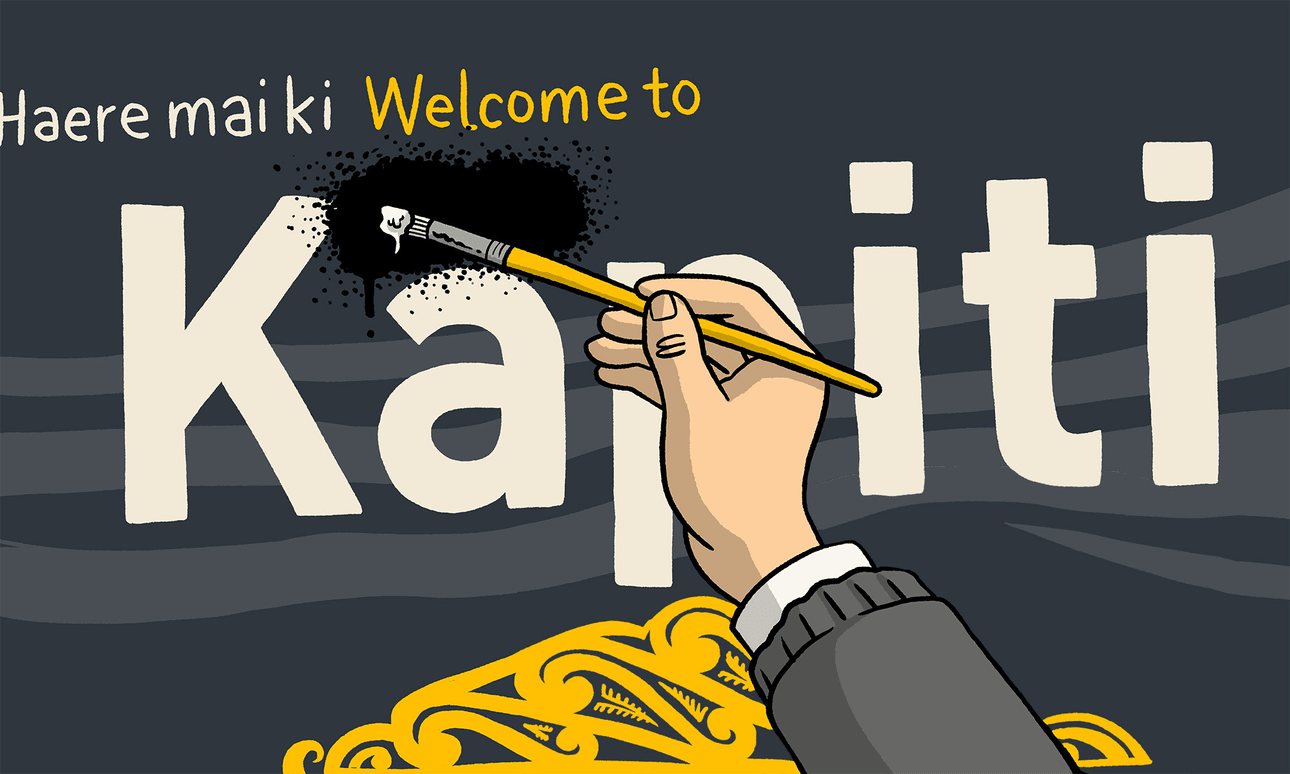First the locals were adding a macron to the Kāpiti welcome sign and detractors were removing it. Now it’s the other way around. So is it Kāpiti or Kapiti?
In April 2021, Stuff ran a story about the curious case of the missing macron, leading with the headline: “Ladder-toting ‘vandals’ add macrons to Kāpiti Coast signs”. Driving through Kāpiti this summer and seeing the signs updated with proper macrons gave me a big smile, and a wee chuckle, thinking about the vandals from the 2021 story who could now perhaps be more accurately described as volunteer copy editors.
Obviously I don’t endorse vandalism of city property, but I did take a moment to enjoy the irony of vandals vandalising vandalism, with macrons being added and subtracted like a communal algebra equation. It is great to see wrongs being righted, but when Toby Morris contacted me for his latest Side Eye regarding this very subject, I realised that there is still some confusion around the use of the macron. So, strap yourself in for a shotgun lesson in Māori linguistics.
The origins of Kāpiti
Kāpiti, spelt with a macron over the ā, can be understood as a transliteration for “cabbage”. So, on a superficial level, there does initially appear to be grounds for the complaints of some critics, who in the past were opposed to living in a town called Cabbage. However, the name of the town predates the arrival of Europeans, so a transliteration of any such English word would be implausible without the help of a time-travelling vegetarian. Note also, for the record, cabbage trees are called tī kōuka.
The origins of Kapiti
The Kapiti name more correctly derives from the full name of the Ngāti Toa island fortress made famous by the heroic seven-mile swim of Kahe Te Rau-o-te-Rangi from Kāpiti Island to Te Uruhi on the mainland. The full name is “Ko te Waewae Kapiti o Tara rāua ko Rangitāne” and it describes the island as the meeting place of the two regional boundaries between Tara and Rangitāne, descendants of the famed navigator Whātonga who travelled to Aotearoa New Zealand upon the Kurahaupō waka.
This version of the name “Kapiti”, without the macron, refers to the idea of connection or two areas coming together, which does align with the historical narrative of the boundaries between the people of Tara and Rangitāne.
But before you jump the gun and start sharpening your erasers, there is more to the story, so just taihoa ake nei for a second. The name Kāpiti predates the arrival of Ngāti Toa and iwi from Waikato and Taranaki in Wellington, and it is likely that the word Āpiti would have been commonly used by the descendants of Whātonga. Āpiti is still commonly used as a place name in areas like Palmerston North where Rangitāne are strongly represented today.
So which one is correct?
Right now, it’s Kāpiti. The current spelling and pronunciation retains the long ā vowel sound from the Kurahaupō dialect though officially the addition of the macron is more a linguistic aid, to help with correct pronunciation. For the record, the correct phonetic pronunciation is “Car-pity” not “Cap-itty”. It’s a small change, but those little mistakes happen all over the country, butchering te reo Māori across the nation. All these little mistakes add up to one really big problem we have with our ability to talk about ourselves. Fortunately for us, the correct pronunciation of Kāpiti is an easy fix.
There is still more to the story, but those stories belong to Ngāti Toa, Rangitane, Muaupoko and the various iwi who are connected to this place by these names and histories. It is for them to tell those tales. For me, the real story here is less about the actual spelling, and more about the joys of Aotearoa New Zealand learning to come to terms with these fascinating and complex histories we have inherited.
So what’s the lesson here?
Being an ally can sometimes be a difficult task, when best intentions are met with conflicting perspectives. I imagine there must have been quite a bit of confusion when some Māori in the community advocated for the retention of the previous spelling, sans macron. But just like any other community, Māori aren’t always united on every issue, including spelling.
You will no doubt remember the 2017 furore around the spelling of Whanganui and Wanganui, when the nation struggled to get our collective heads around the subtle dialectal variations of place names and pronunciation from region to region and iwi to iwi. In 2023 I’d like to think that we’re maturing as a nation, settling into our multicultural skin, more able and willing to accept cultural nuance as an important and definitive aspect of our identity.
The Treaty Partnership relationship is like any other relationship. Sometimes we need to listen to our partners better and stop trying to be right all the time, to really hear what they are trying to tell us. In this instance, the decision to keep the macron is largely to do with correcting many decades of poor pronunciation. So, if you can just remember the macron makes a Car, not Cap, sound, you’ll be speaking perfect reo Māori each time you say Kāpiti correctly in the future.
Mauri ora kia koutou katoa.





